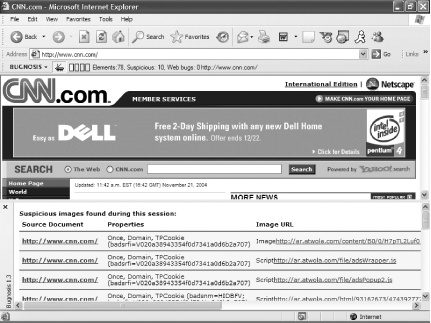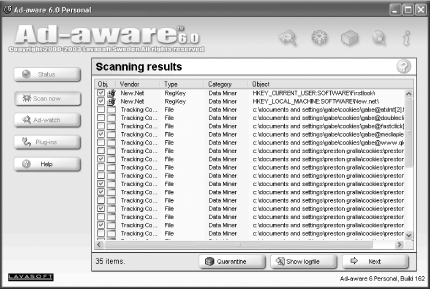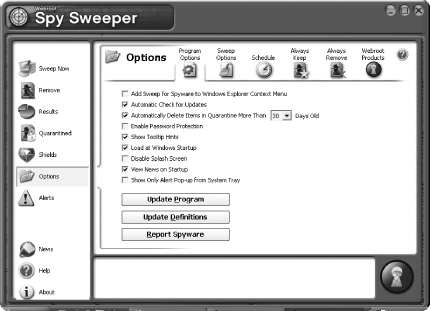Hack34.Kill Spyware and Web Bugs
|
Hack 34. Kill Spyware and Web Bugs
You don't have to be victimized by obnoxious applications that spy on you, hijack your browser, or worse. Fight back with these tips and tools. For most people, spyware has replaced viruses or worms as the most-feared and obnoxious danger on the Internet. A relatively few number of people become infected by viruses or worms, but it seems as if almost everyone you know has been hit by some kind of spyware. Spyware is a catch-all phrase that encompasses many different types of obnoxious programs. The least intrusive of the bunch report on your surfing activity to a web site, which tracks what you do and then delivers ads to your PC based on your interests. But increasingly, they are becoming more intrusive. Some of them spawn pop-up swarms of ads that appear so quickly they overwhelm your PC, slowing it down and making it unusable. Others hijack your browser home page so that no matter what you do, you're sent to a home page of the hijacker's choosing, which might be a pornographic site, or perhaps a web site that spawns even more pop ups. And some kinds of spyware, called keyloggers, literally spy on you by watching every keystroke you make, and then send that information to someone on the Internet. Web bugs are invisible bits of data, frequently a single pixel in size (sometimes called clear GIFs), that can track all your activities on a web site and report them back to a server. You don't have to be victimized, though. As you'll see in the rest of this hack, there are things you can do to keep spyware and web bugs at bay. 4.4.1. Watch Out for Web BugsWeb bugs are one of the more pernicious ways your online activities can be tracked, no matter which browser you're using. Sometimes, the web site the bugs send information to isn't the one that contains the web bug; for example, a web bug might send information back to an online advertising network. Web bugs are surprisingly common. The Cyveillance technology and analysis company found that their use grew nearly 500% between 1998 and 2001. Web bugs can send the following information back to a server:
A free piece of software called Bugnosis (http://www.bugnosis.org) will alert you whenever it comes across web bugs on pages you visit. It reports on the URL the bug reports to, and, for some bugs, it will let you click a link it creates so that you can send an email of complaint to the web site that runs the bug. It runs inside Internet Explorer as a toolbar, and doesn't work with any other browsers. The software can't actually protect you against web bugs, but it can alert you when you visit pages that use them, so you'll know if you want to stay away from them in the future. When you visit a site, the Bugnosis toolbar reports on the number of suspicious items that might be web bugs. To see detailed information about each suspicious item and web bug, click the down arrow next to the Bugnosis logo and choose Bugs Found in This Session. You'll see a list of every suspicious web bug, as you can see in Figure 4-6. Click the item, and you'll see a more detailed description, and an analysis on whether the item is truly a web bug, or only suspicious. Figure 4-6. Bugnosis in action Bugnosis can't actually block web bugs; it can only alert you to their presence. If you want your privacy protected when you surf the Web, your best bet is to surf anonymously [Hack #36] . 4.4.2. Protect Yourself Against SpywareSpyware is becoming ubiquitous and nastier as well. But you don't have to be a victim; there's a good deal you can do to protect yourself:
One of the best and most popular free ones is Ad-Aware, available from http://www.lavasoft.de. It checks your system for spyware, finding not only program files, but also Registry entries and cookies, as shown in Figure 4-7. After it does a check, you can choose which spyware problems you want the program to fix, and it'll go about its work, deleting files, folders, and cookies, and fixing Registry entries. Because no one spyware-killer is perfect, I suggest getting another free one, Spybot Search & Destroy, from http://www.safer-networking.org/en/index.html. Use both of them regularly to keep your system clean. Figure 4-7. Finding and deleting spyware on your system with Ad-Aware
Ad-Aware and Spybot Search & Destroy do good jobs of finding and killing spyware after it's already infected your system. But better still is to get software that will stop the infection altogether. An excellent one is Webroot Spy Sweeper, available from Webroot Software at http://www.webroot.com. You can download it and try it for free; if you continue to use it, you have to pay $19.95 per year. It does an excellent job of warning you when spyware tries to infect your system, and then stops it. It will also warn you when any program tries to start up automatically when XP starts, and when any program tries to change your home page. And like Ad-Aware and Spybot Search & Destroy, it will scan your system for spyware and then eradicate it as well. Figure 4-8 shows the program's configuration screen. Figure 4-8. The Spy Sweeper configuration screen
Ad-supported programs can include spyware, though not all do. Check out the Index of Known Spyware page run by Gibson Research at http://grc.com/oo/spyware.htm for a list of spyware programs.
A personal firewall will let you block any program on your system from contacting the Internet without your approval, so you can use it to block spyware. XP's Windows Firewall doesn't have this capability, so you can't use it to block spyware.
Pop-up ads are a common way of delivering spyware. Click a pop up, and you might get infected with spyware. So, kill pop ups. For details, see [Hack #33] .
A web site might attempt to download software to your PC without your knowledge, and it might carry a spyware payload. Install SP2; it includes a download blocker. Additionally, the Firefox browser [Hack #43] includes a download blocker as well.
Antivirus software protects you against some spyware, so make sure you run antivirus software and keep it updated. 4.4.3. See Also
|
|
EAN: 2147483647
Pages: 191

 Performance and Maintenance
Performance and Maintenance 